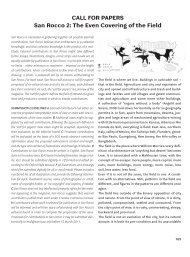CALL FOR PAPERS San Rocco 4: Fuck concepts! Context!
CALL FOR PAPERS San Rocco 4: Fuck concepts! Context!
CALL FOR PAPERS San Rocco 4: Fuck concepts! Context!
- TAGS
- papers
- rocco
- fuck
- sanrocco.info
You also want an ePaper? Increase the reach of your titles
YUMPU automatically turns print PDFs into web optimized ePapers that Google loves.
architecture enthusiastically embraced all sorts of<br />
trashy allegories. But did this populistic attempt really<br />
work out? For all its love of cheap slogans, contemporary<br />
architecture is still highly non-communicative,<br />
misunderstood and neglected. Any other art form<br />
works better, and any other expressive medium (considering<br />
architecture, just for the sake of argument, as<br />
an expressive medium) has higher returns. Why should<br />
we not learn from this failure? Why should we not accept<br />
this situation and make use of it? Consider how<br />
successful contemporary art has been in being deliberately<br />
obscure. Maybe what is wrong with contemporary<br />
architecture is precisely its (modernist) humbleness,<br />
its desperate eagerness to sacrifice itself in the name<br />
of something else.<br />
• A Defence of Concepts •<br />
Over the last four centuries, <strong>concepts</strong> have been very<br />
popular. As a result, a large majority of our readers<br />
might be irritated by (or at least have doubts about)<br />
our argument against <strong>concepts</strong>. So, please explain to us<br />
why we are wrong. You know we are open-minded.<br />
• Stirling’s Non-dogmatic<br />
Accumulation of Formal Knowledge •<br />
Stirling is often considered a stupid architect, probably<br />
partly because (at least in the second part of his career)<br />
he didn’t write, and what has appeared in print is indeed<br />
a mishmash of statements, vague interviews and<br />
sloppy prize acceptance speeches. It is also probably<br />
partly because he seemed so strangely inconsequential<br />
in his trading in of British industrialist brickwork<br />
for pink, oversized railings. In his “inconsequential” actions,<br />
however, Stirling was a fundamental contextualist,<br />
though his context was not the gloomy universe in<br />
which he was supposed to place each of his buildings,<br />
but the one that he constructed himself along the way.<br />
For Stirling, the series of preceding formal solutions<br />
created the context for the new ones he would develop.<br />
In each of his commissions, reality turned out to<br />
be confrontational yet fertile. Over time, Stirling put<br />
together a body of non-dogmatic formal knowledge<br />
172<br />
comprised of imprecise sources, inconsequential fascinations,<br />
bad jokes and out-of-place erudition. But then<br />
again, imprecision can generate a world if one is stubborn<br />
and consistent and ignorant enough not to care<br />
too much about it.<br />
• Le Corbusier, a <strong>Context</strong>ual Architect •<br />
Despite his initial claims for a new universal, machineinspired<br />
architecture, a number of essays from L’Esprit<br />
nouveau (later to be included in Vers une architecture)<br />
communicate Le Corbusier’s deep interest in specific<br />
landscapes such as the Acropolis in Athens or the city<br />
of Rome. Le Corbusier considers the Acropolis to be<br />
an architectural device that provides the key to the interpretation<br />
of the entire landscape lying between Piraeus<br />
and Pentelikon. Convincingly enough, Colin Rowe<br />
states that the La Tourette monastery acts in the very<br />
same way with respect to its context. On another scale,<br />
it is easy to consider the series of projects ranging from<br />
Plan Obus to the sketches for South American cities as<br />
obvious members of the same family. Among the apparently<br />
most un-contextual operations, even the Plan<br />
Voisin or the Beistegui attic clearly fit within the very<br />
specific Parisian context of the Haussmannian erasures<br />
and the cult of the urban axis, curiously coupled<br />
with the surrealistic excision of the Cadavre Exquis.<br />
• Why Architecture by O. M. U. (Peace Be Upon Him)<br />
Always Looks So Bad •<br />
The architecture of Oswald Mathias Ungers is always uncomfortable,<br />
uneasy and fundamentally unhappy. And<br />
the worst thing about it is that you always suspect that<br />
there is some sort of reason for this; you always have<br />
the feeling that its failures exist on purpose, or that its<br />
shortcomings are supposed to tell you something. Ungers’s<br />
architecture is an example of how <strong>concepts</strong> can<br />
destroy all good presuppositions. In fact, Ungers was<br />
right on almost every level. He was intelligent, educated<br />
and realistic, had a precise notion of monumentality<br />
and an impressive understanding of the city, and he did<br />
not lack good taste. He may also have had some sort of<br />
(German) sense of humour. Still, he felt the need to turn




